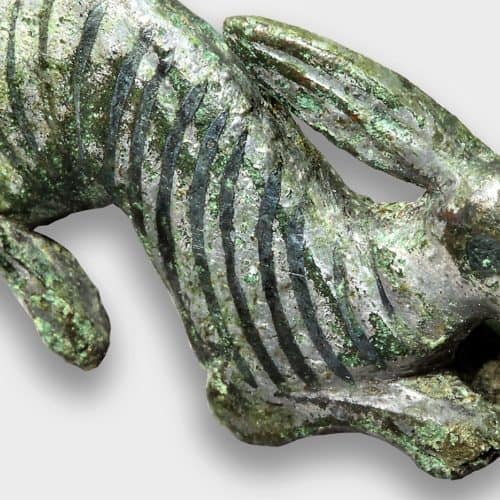Romans activity 7: Blingy things
Overview
Design a Roman brooch based on the example from Folkestone Roman villa or from internet research.
Image copyright: Canterbury Archaeological Trust
Learning objectives
Increased knowledge and understanding of archaeology and Folkestone Roman Villa.
Research skills.
Art and design skills (create a Roman brooch).
Curriculum links
KS1-2 History (Romans, Local History Study).
KS1-4 Art and Design (make a Roman brooch).
The class investigate Roman jewellery using the photo of the silver hare brooch found at Folkestone Roman Villa as their starting point. See Learn with Objects Romans 8: Blingy things.
What is this item? Which animal is it? Who do you think wore it and why? They then broaden out their enquiry to explore Roman jewellery as a whole, and what it reveals about life in Roman times and of course Roman fashion. These are useful websites.
https://coriniummuseum.org/schools/resources/roman-jewellery/
https://en.wikipedia.org/wiki/Roman_jewelry
The intaglio (carved gemstone) from a finger ring found on the Folkestone Roman Villa site (Learn with Objects Romans 8: Blingy things) is made from carnelian. It probably came from the Indus Valley in the Middle East, and was traded into and across the Roman Empire to Folkestone.
See an example of an intact gold ring with carnelian setting from the collection of the John Hopkins Archaeological Museum.
Pupils then create their own Roman animal brooch inspired by a favourite example they’ve discovered.
Animal brooches are called zoomorphic brooches by archaeologists - from the Greek words zoon (animal) and morphe (shape). It’s where we get our word zoo from.
Examples from the Roman period include dogs, horses, peacocks, owls, dolphins, wild boar, rams and fish. The following website include links to excellent examples in museum collections in Britain and around the world:
Design a Roman brooch
Brooches can be made from a wide range of craft and recycled materials including bronze, silver and gold craft foil, Fimo clay, thick white card, plastic jewels and cut up pieces of coloured acetate. Use black felt pens to add in some of the details.
Large safety pins and sticky tape are useful for fixing the completed brooches to clothing.
Top tip: Create the brooches much larger than the Roman originals so they stand out, and are not so fiddly to work on. Suggest A6 size (quarter of a sheet of A4).

